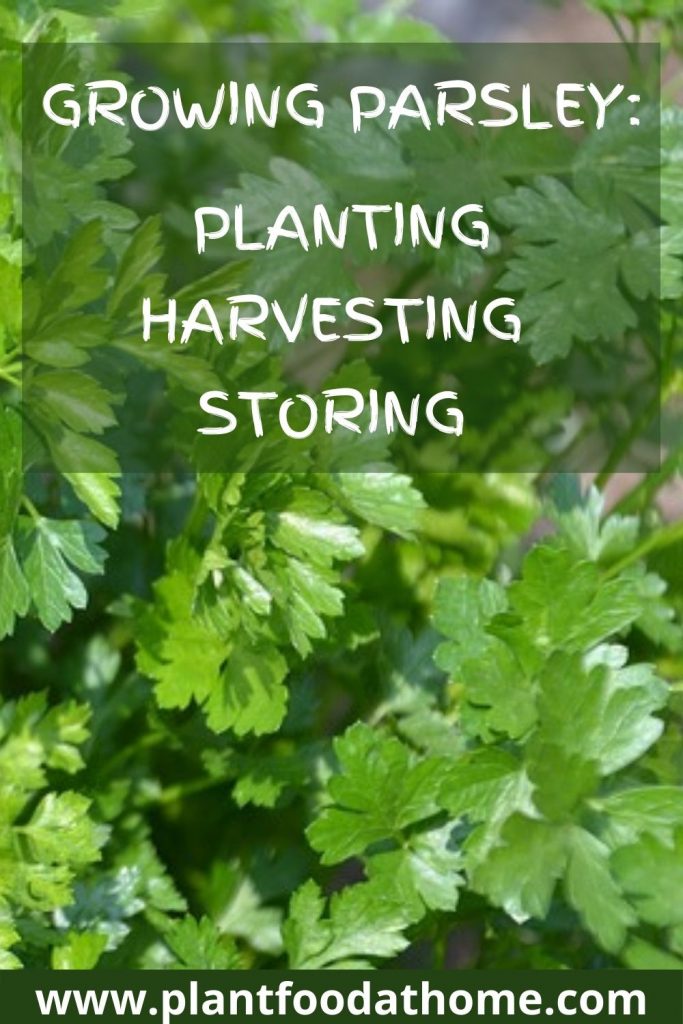Parsley is a widely used and versatile herb and it’s easy to grow indoors or in an outdoor herb garden. We show you how to grow parsley so you can add this aromatic herb to flavor your favorite dishes or to garnish a plate. Discover these growing parsley tips, for all about planting, harvesting and storing parsley with this practical guide.
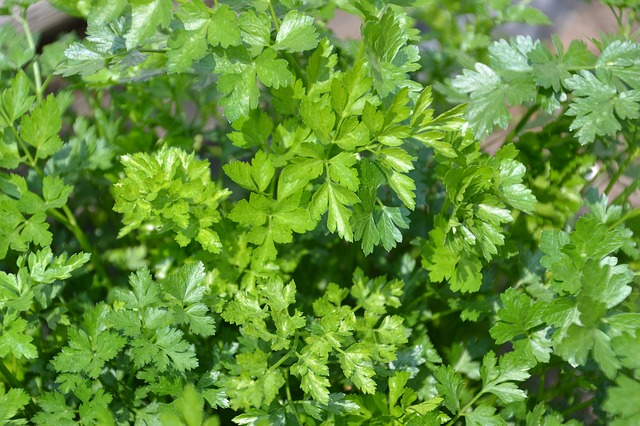
The botanical name for parsley is Petroselium crispum and it comes from the Apiaceae family, the same family as carrots and celery.
There are two general varieties of parsley: the French curly leaf parsley and the Italian flat leaf parsley. The flat leaf variety is argued to have a stronger flavor than the curly leaf parsley, but both types are relatively mild in flavor.
Parsley makes an attractive plant in the garden so you might like to grow both types of parsley.
Table of Contents
Parsley Growing Conditions
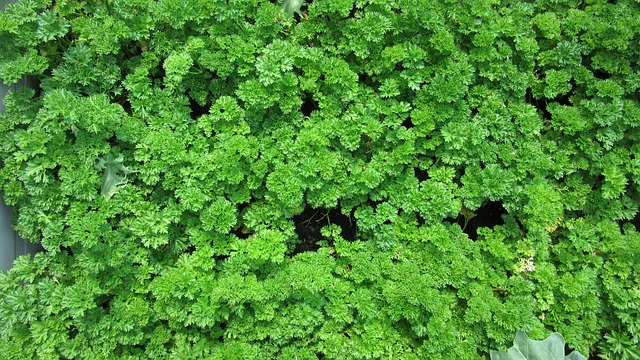
The best growing conditions for parsley is when soil temperatures are 50-86 °F (10-30 °C). You can check soil temperature with a soil thermometer.
Parsley can be grown in many climates but will behave differently according to the temperature. For example, in colder climates, the herb will be an annual and will have to be re-planted each year. And in warmer climates, the herb will be a biennial and return the following year after planting. Planting new seeds every other year in warmer climates ensures a yearly crop of fresh parsley.
If parsley is allowed to flower in the garden, it will then seed and produce new plants all by itself when the conditions are right. In fact, in the right growing conditions, parsley can be so prolific, it will grow in unexpected locations such as the lawn and cracks in the pavement!
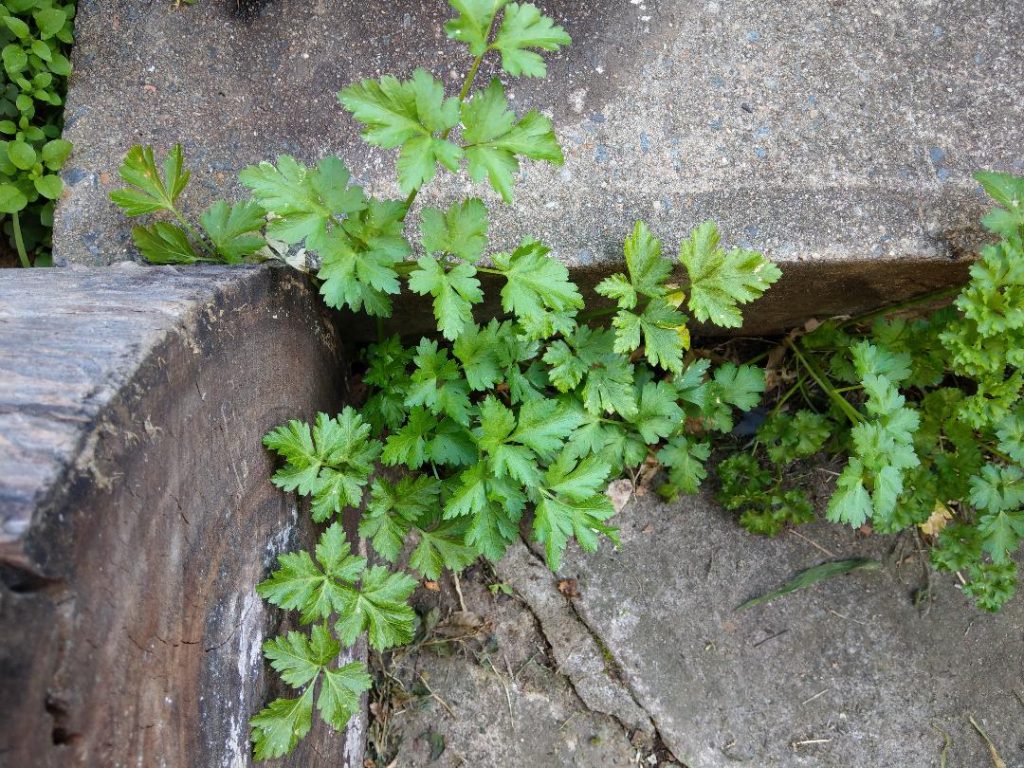
Soil Requirements
This herb prefers neutral soil with a pH of between 6 -7. You can do a soil test to determine the pH and add required amendments to bring the soil into the neutral 6-7 range. Lime or sulfur is typically used to adjust the pH level of outdoor soil and potting soil with a pH of 6-7 can be purchased for growing parsley in pots and containers.
The planting soil also must be loose and drain well so the tiny roots will not have to struggle to grow in the soil. To get the right soil for best plant growth, mix soil with organic compost and well-rotted manure.
Light Requirement
Plant parsley where it will receive full sun of 6-8 hours a day.
Parsley will also do well in a location that receives morning sun and partial shade in the afternoon. A couple of hours of morning sun and dappled afternoon sunlight is perfect for this herb to thrive in when growing in warmer climates.
Water Requirements
Depending on your climate, parsley may need to be watered 2-3 times a week. Or water anytime the top of soil is dry to the touch. You can also use a water gauge to monitor the soil moisture.
The leaves can begin to wilt if the plant is not receiving enough water. But over-watering can cause root rot – so ensure the soil is free-draining to prevent this.
Fertilizer
Mix compost and well-rotted manure into the soil at planting time to get parsley off to a good start in fertile soil. The compost will feed the soil, prevent compaction, promote soil drainage, and encourage the development of a healthy bio-diverse sub-culture.
Growth can also be supported with an organic herb plant food fertilizer. And if growing parsley in pots, fertilizer is more important as soil nutrients will be depleted faster by watering.
Mulching
Use an organic mulch around the base of the parsley to protect the soil from moisture loss and to help protect the roots. Mulch also breaks down over time to help feed both the soil and the parsley plant.
Growing Parsley From Seeds
Parsley seeds have a tough outer shell and can be soaked in water overnight to help soften the shells before planting if you choose. This process can help improve germination but it is not essential.
To get a head start on the growing season, parsley can be started in pots indoors 10-12 weeks before planting outdoors. This long time frame is because parsley seed can be slow to germinate, sometimes taking 4-6 weeks to emerge.
For planting these new seedlings out in the garden, wait for the soil to reach the ideal temperature 50-86 °F (10-30 °C) and for the seedlings to develop at least two sets of true leaves.
A seedling heat mat and indoor grow lights can help with indoor seed germination.
Parsley seedlings raised indoors, need to be ‘hardened off’ before planting outdoors. This is simply the process of gently exposing the seedlings to outdoor conditions over a period of 7-10 days. You can read more in our article Hardening Off Seedlings (& Avoiding Transplant Shock).
How To Grow Parsley From Seed
In early spring after all danger of frost has passed, parsley seed can be planted in prepared soil at about 1/4 inch deep (1/2 cm). Sprinkle a few seed for each planting hole around 3-4 inches (7-10 cm) and later thin to 8-12 inches (20-30 cm) apart. Water newly planted parsley seed thoroughly and then continue to keep the soil moist until seeds germinate.
To plant seed in pots for growing outdoors or indoors, place two-three seeds in the center of a 6 inch (15 cm) or larger container. Sprinkle seeds with soil and water thoroughly. Keep the soil lightly moist until the parsley seeds germinate. Depending on the pot size, you can sprinkle more seed to help increase the rate of successful seed germination and later thin so each plant has at least 8 inches (20 cm) of room to grow.
Growing Parsley In Pots
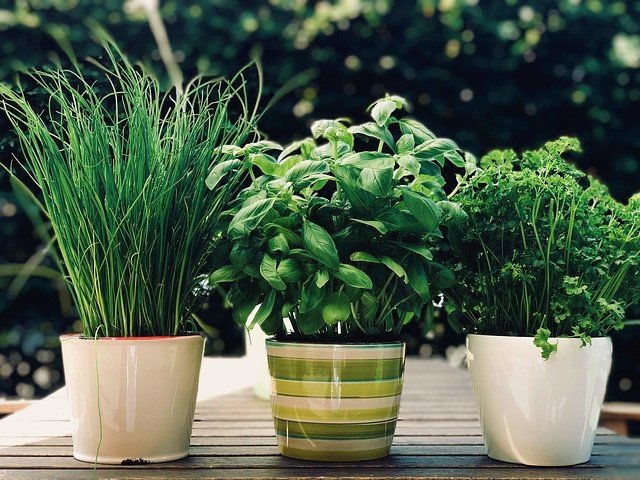
Parsley can easily be grown in pots or containers. This allows gardeners to grow parsley both indoors and outdoors.
When grown indoors in pots, planting seeds every few weeks will provide a steady supply of fresh parsley year around.
Choose a quality organic potting mix to give parsley all the soil nutrients it will require for healthy growth.
If the pot will be located outdoors, place it in a location that receives morning sun and afternoon shade.
For indoor growing, place the pot near a window so the plants will receive plenty of sunlight.
Keep parsley well watered and fertilize every few weeks to replace soil nutrients.
Harvesting and Storing Parsley
Parsley typically grows 8-12 inches (20-30 cm) tall and wide and is ready to be harvested when the leaf stems have three segments. The time it takes parsley to grow is usually between 9-19 weeks.
To harvest parsley, simply cut leaves from the outer portions of the plant as needed. This will promote new growth of leaves in the center of the parsley stalk.
Store harvested parsley in a glass of water in the refrigerator, changing the water every few days. Parsley should keep fresh for a week or two. Covering the glass of parsley loosely with a plastic bag can extend the shelf life by an additional week or so.
Parsley can also be dried or frozen to preserve the harvest.
To dry parsley lay clean parsley on a paper towel for a few days until completely dry. Alternatively, form bunches of parsley, tie them together and hang them upside down in a bright airy spot. And for a faster result, you can use a food dehydrator or dry parsley in the oven on a very low temperature.
Once dry, parsley will be crumbly and can be crushed finely to store in an airtight container or jar. Store away from direct sunlight and best used within 12 months for optimum flavor.
To freeze parsley, there are a number of methods but the easiest is to simply wash well, dry well and then place the parsley in a freezer bag for freezing. Ensure the air has been removed from the freezer bag and seal it well.
Dried and frozen parsley won’t replace the flavor of fresh parsley but it does mean you can use parsley all year round to enhance the flavor your dishes.
Pests And Disease
Parsley is fairly low maintenance and not often bothered by pest and disease. But here are a few of the more common problems to look out for and how you can treat them.
Aphids love the flavor of parsley and can be blasted off with a spray of water if they infest the herb patch.
Leaf spot is a fungus that causes leaves to develop brown spots with a golden halo around the edge. Blight is also another fungus common to parsley. As well as crown and root rot. These problems usually show up as a result of humid conditions and wet soil. To prevent and treat these common diseases, thin plants to promote good air circulation and avoid getting plant leaves wet when watering.
Powdery mildew can affect parsley on occasion. You can treat this naturally with a DIY milk spray for powdery mildew.
FAQ – Frequently Asked Questions
Q: How long does it take parsley to grow?
Parsley typically takes 9-19 weeks until it’s ready to start harvesting.
Q: How much space does parsley need to grow?
For best results, give parsley 8-12 inches (20-30 cm) of growing room.
Conclusion
This aromatic herb is a must for the herb garden. Planting parsley will enhance many dishes and makes a wonderful addition to the edible garden. And being easy to grow, why not give it a try?
Recommended Products:
- Heirloom Herb Seeds
- Organic Herb Fertilizer
- Water Gauge
- Organic Seed Raising Soil
- Soil Thermometer
- Organic Potting Soil
- Seedling Heat Mat
- Grow Lights
- Food Dehydrator
For more herbs to grow you might like to see our other articles:
- How To Grow Cilantro: Tips For Growing Cilantro
- Grow Lemongrass: Planting and Growing Guide
- How To Grow Mint: Complete Guide To Growing Mint At Home
- How To Grow An Abundance Of Dill For Your Edible Garden
- Drought Hardy Herbs To Plant At Home
- How To Grow Ginger: Guide To Growing Ginger At Home
- How to Grow Lemongrass: Planting and Growing Guide
And for cooking with parsley:
